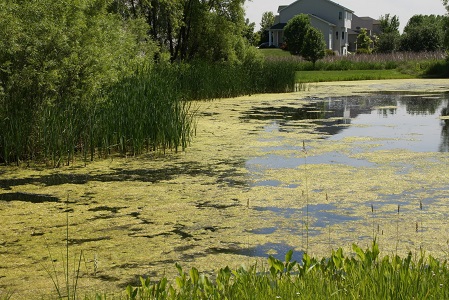November 16, 2023 – When looking at the old fishing hole or stock tank, if there’s a thick mat of bubbly yellow-green substance floating on the surface of the pond, or the pond appears to be colored bright green, blue-green, or sometimes even red, then there may be an algae problem. Algae overgrowth is one of the most common issues plaguing pond owners.
The first step to effective algae management is to understand what type of algae resides in the pond. There are three different types of algae commonly found in farm ponds and small lakes: planktonic algae, filamentous algae, and macroalgae.
PLANKTONIC ALGAE (THE GOOD) Planktonic algae are the microscopic, single-celled, and free-floating algae that exist in the top few feet of a pond or lake where the sunlight penetrates. This type of algae is what gives the water a green coloration, a plant mass does not have to be visible. Planktonic algae are normal and are in fact desirable, because they are essential to the pond’s food chain. Planktonic algae (phytoplankton) provide food for the microscopic animals (zooplankton) that are eaten by fish fry, baitfish, and other pond inhabitants, which ultimately support a larger fish population. They display seasonal abundance, with explosions of growth called ‘blooms’ in the spring or summer that often change the color of the pond. Planktonic algae are also important in oxygenation of the pond as they photosynthesize during the day creating oxygen as a byproduct. Rapid die-off due to algaecide treatments or natural degradation of algal blooms can lead to oxygen depletion and fish kills in Quick Fact: In some cases planktonic algae (more specifically, protists of the genus Euglena) can turn from green to red in the pond.
Quick Facts: The quickest way to treat algae in ponds is with copper based algaecides such as chelated copper complexes or copper sulfate. However, integrated management practices are the most effective way to manage algae in ponds and prevent it from quickly returning after an algaecide treatment.
A combination of the following typically produces more effective, long term algae control: aeration; creating a 10’ to 20’ buffer zone around the pond with taller vegetation to filter excess nutrients; decreasing the amount of fertilizer used on lawns and forage fields near the pond; preventing livestock from defecating in or near the pond; locating septic fields far away from ponds; deepening the edges to a slope of 2:1 decline; or a chemical treatment followed by a fertilization program for the good planktonic algae in the pond.
For more information on this or any other agricultural or natural resources topic please contact the Hopkins County Extension Office at 903-885-3443 or email me at [email protected].








